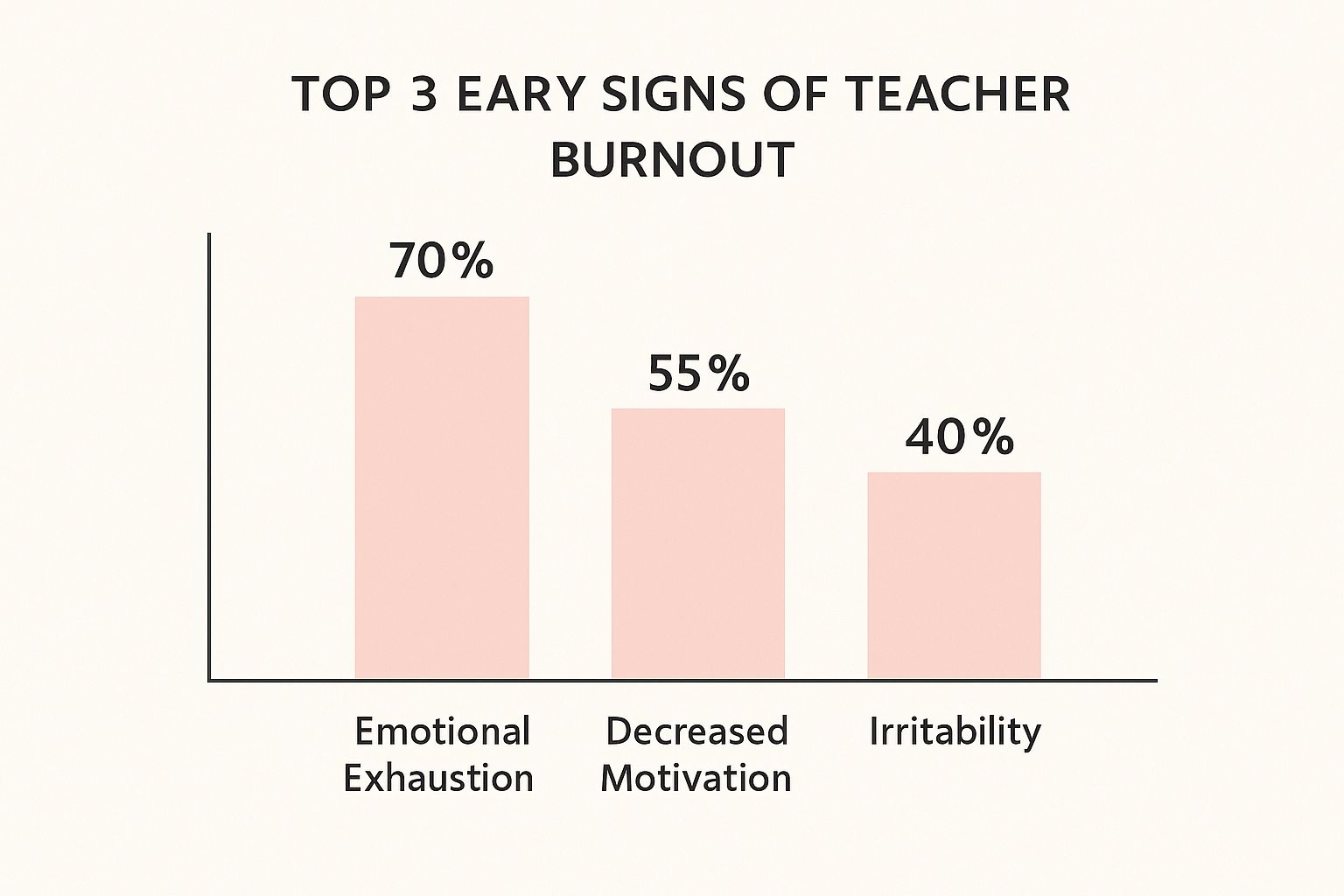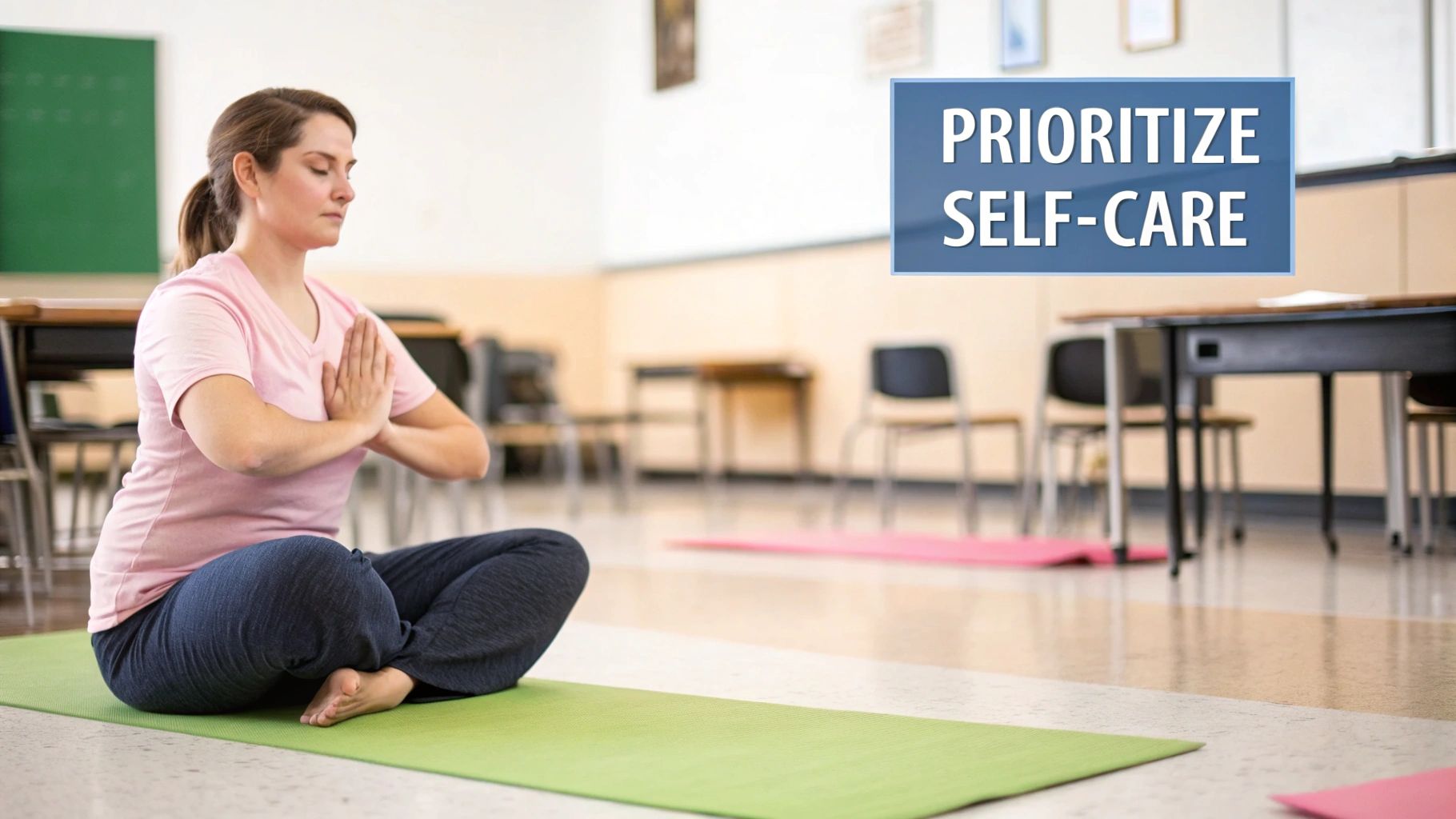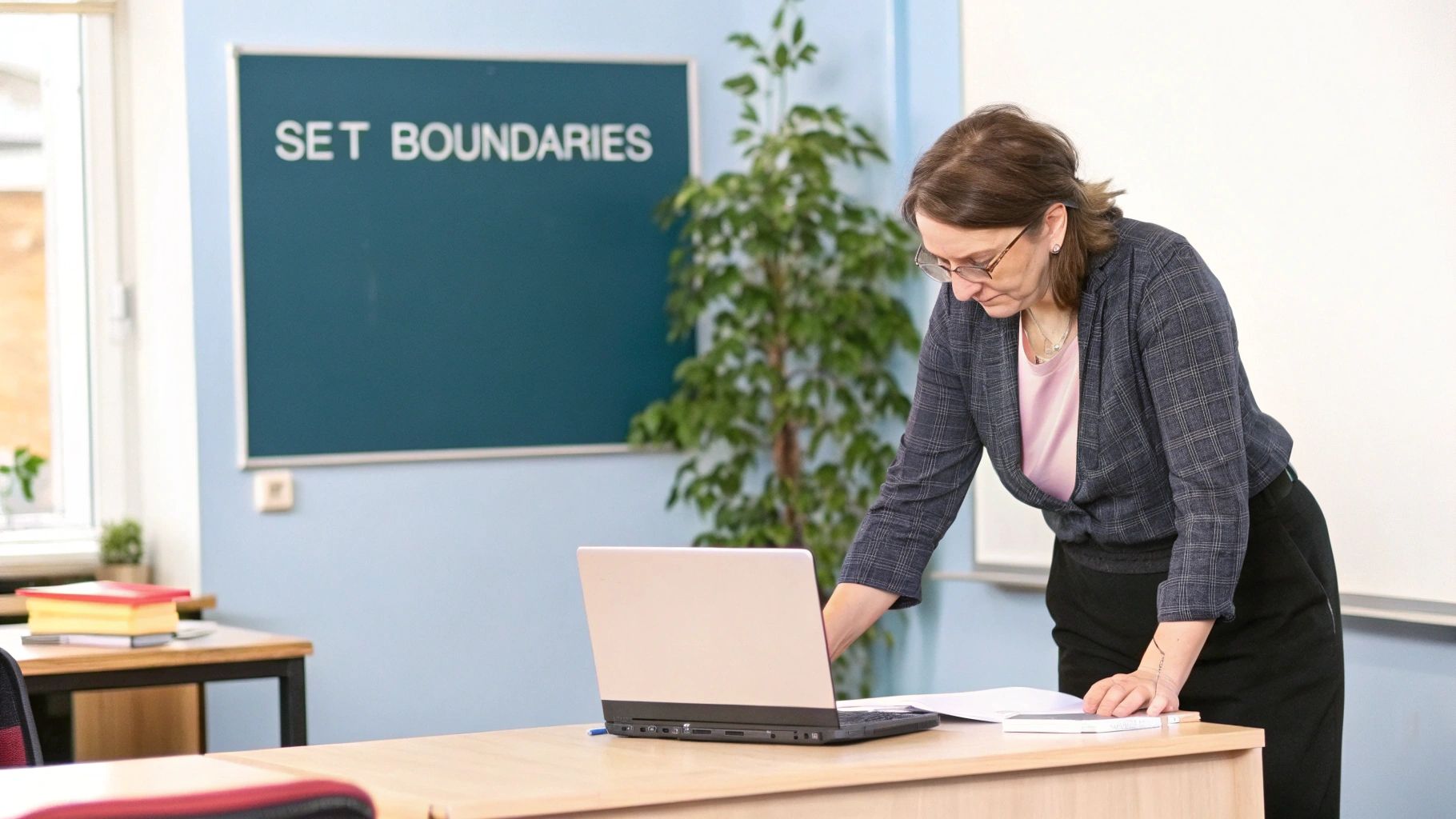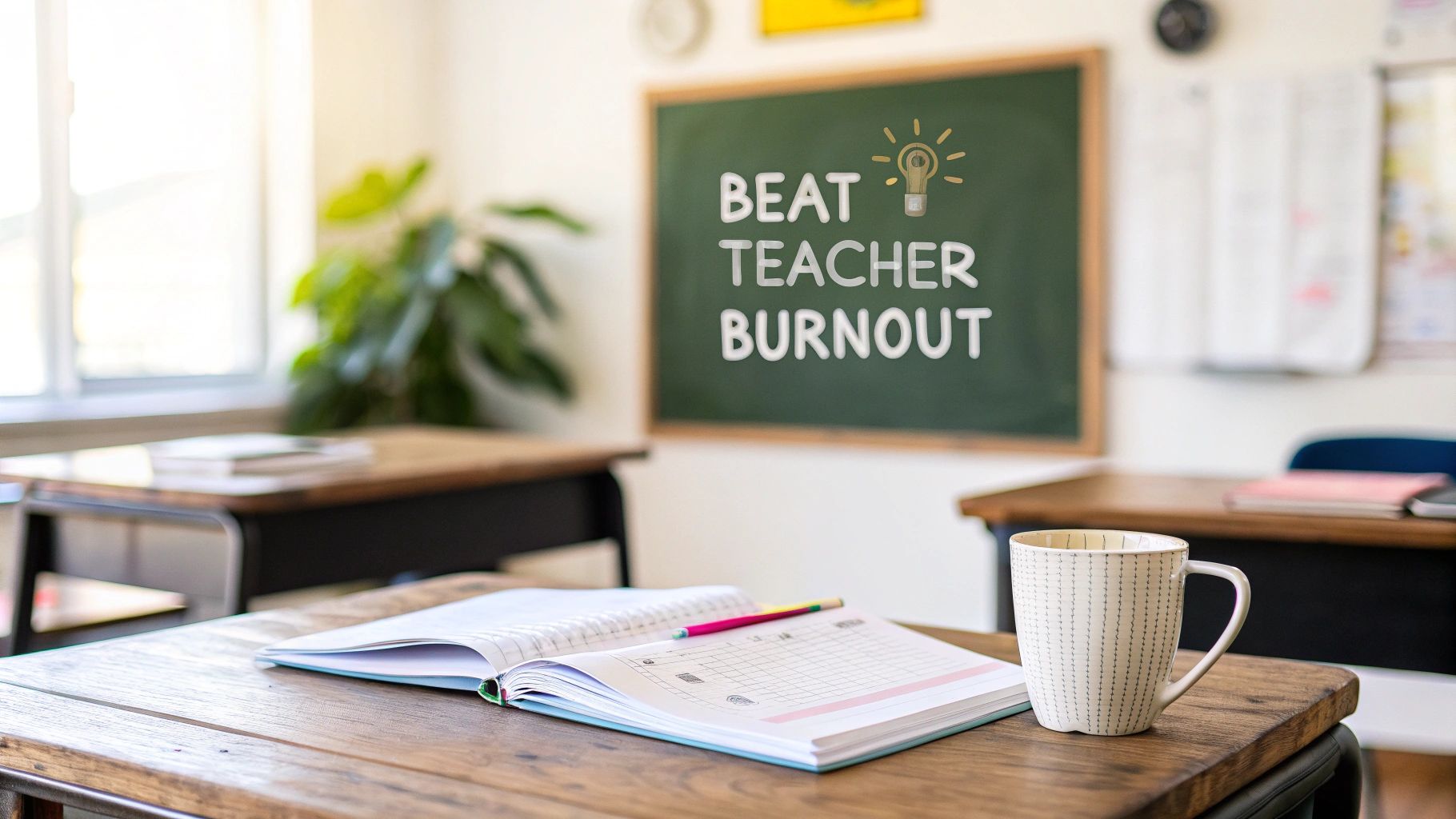If you're reading this, you know that teaching is more than a job—it's a calling. But even the most passionate educators can feel their flame start to dim under the weight of daily pressures. Preventing teacher burnout isn't about a massive overhaul; it's about weaving small, intentional habits into your life that protect your energy and rekindle your love for this incredible profession.
By blending focused self-care, strong boundaries, and smarter classroom systems, you can shift from just surviving to truly thriving.
A Framework for a Sustainable Career
Think of this guide as your personal roadmap to a long, joyful, and impactful teaching career. The goal is to integrate wellness into your daily fabric, not treat it as an afterthought. This sustainable approach is built on three core pillars:
- Personal Well-Being: This is your foundation. Guarding your mental and physical health builds the resilience you need to navigate even the toughest days.
- Professional Boundaries: Setting firm, clear limits is the key to protecting your personal time and preventing your energy from being drained.
- Efficient Systems: Streamlining your tasks reduces daily friction, freeing up precious mental space and energy for what truly matters—your students.
Focusing on these areas empowers you with a sense of control and a clear path forward.
This is what the early stages of burnout often look like for teachers.

As you can see, emotional exhaustion is the first domino to fall for a staggering 70% of educators. Decreased motivation (55%) and irritability (40%) follow closely, highlighting exactly where our prevention efforts need to be focused.
A Quick Guide to Burnout Prevention Strategies
Here is a summary of the core strategies discussed in this guide, providing a quick-reference framework for educators.
| Strategy Area | Key Action | Primary Benefit |
|---|---|---|
| Self-Care | Schedule daily micro-breaks | Restores focus and reduces stress |
| Boundary Setting | Define no-email hours | Protects personal time |
| Classroom Systems | Batch administrative tasks | Frees mental bandwidth |
These aren't just suggestions; they are the essential building blocks of a sustainable and deeply fulfilling teaching career.
It’s Not Just You—It’s the System
Let’s be clear: teacher burnout is not a personal failure. It’s a systemic issue reflecting challenges within the education landscape. An astonishing 44% of K-12 teachers in the United States report feeling burnt out, fueled by a perfect storm of low wages, relentless policy changes, and crushing workloads.
The emotional toll is significant, with research indicating that educators often experience higher rates of stress and depression compared to many other professions. For a deeper look at the data, Devlin Peck provides eye-opening insights.
When schools prioritize teacher wellness, they cultivate stronger, more resilient communities where both students and educators can flourish.
This mindset is the launching pad for the powerful, actionable steps we’re about to explore.
What’s Next?
Coming up, we’ll dive into practical strategies you can implement immediately. You’ll find targeted self-care routines you can actually stick to, simple classroom tweaks that save incredible amounts of energy, and even concrete scripts for saying "no" guilt-free. Each section is packed with real-world examples to help you build a more sustainable and joyful career.
Build a Resilient Life Outside the Classroom

Here’s a truth we often forget: how you show up for your students is a direct reflection of how you show up for yourself. Preventing teacher burnout begins by weaving small, consistent acts of self-preservation into your daily life to refill your own cup. You cannot pour from an empty one.
One of the most transformative habits you can adopt is a "shutdown ritual." This simple routine creates a clear, mental boundary between “teacher you” and “home you,” signaling to your brain that the workday is officially over. It’s your permission slip to be fully present with your family, your friends, and yourself.
Create Your End-of-Day Shutdown Ritual
This doesn't need to be complex. Just five intentional minutes before you leave can change everything. The magic is in the consistency.
- Action Point: Tidy Your Desk. A quick declutter creates a sense of closure and provides a fresh, organized start for tomorrow.
- Action Point: List Tomorrow’s Top 3. Ditch the endless to-do list that follows you home. Jot down the three most critical tasks for the next day to quiet your mind.
- Action Point: Do One Symbolic Thing. Close a specific binder, shut down your computer with intention, or simply say a quiet "goodbye" to your classroom. This physical act seals the mental transition.
This small habit is a game-changer, stopping work from creeping into your personal time and reclaiming your evenings for the rest and rejuvenation you so deeply deserve.
Reconnect with Your Non-Teacher Self
Remember who you are outside the classroom? Rediscovering your hobbies and passions is not an indulgence—it's essential for your well-being. Your career is a huge part of your identity, but it cannot be all of it.
Schedule these activities as non-negotiable appointments. Whether it’s joining a book club, taking that pottery class, or simply walking in nature, these moments are for you. They remind you that you are a whole, multifaceted person, which builds incredible resilience against the daily grind.
Self-care isn't a reward for being a good teacher; it's a prerequisite for being a sustainable one. Protecting your personal time is protecting your career.
Mindfulness is another powerful tool for decompressing. Even a few minutes of quiet can reset your nervous system. According to the American Psychological Association, mindfulness practices can significantly reduce stress and emotional exhaustion. For inspiration, explore these practical mindfulness activities for teachers that fit easily into any routine.
When you intentionally build a fulfilling life outside of school, you create a deep well of energy to draw from. That is how you show up as your best, most inspired self for your students, day after day.
Redesign Your Classroom to Conserve Your Energy

Your classroom can be an energy drain or a source of support. Let's be honest: preventing burnout often starts right here, with the systems that shape your day. By making a few smart, strategic tweaks, you can reduce the mental load and friction that leave you feeling exhausted.
The key is to shift your role from the director of every activity to the facilitator of a well-oiled classroom. This begins by creating efficient, student-led routines that free you to focus on what you do best: teaching.
Implement Student-Led Systems
One of the most powerful ways to conserve your energy is to empower your students. Think about the repetitive questions you answer dozens of times a day. What if you built systems where students could find those answers themselves? This fosters their independence and dramatically reduces interruptions.
Here are a few practical action points to start:
- Action Point: Self-Checking Stations. Set up an answer key station for practice activities. Students get immediate feedback, and you eliminate a pile of grading.
- Action Point: Peer-Review Protocols. Teach students to give constructive feedback using a simple rubric. This builds collaboration and lightens your grading load.
- Action Point: "Ask Three, Then Me" Rule. A classic for a reason! Encourage students to seek help from three peers before coming to you. It builds problem-solving skills and protects your focus.
These small shifts create a more dynamic and engaging space. For more inspiration, check out these wonderful classroom decoration ideas that blend function with a peaceful atmosphere.
Master the Art of Task Batching
Constantly switching between planning, emailing, and grading is mentally exhausting. This is where task batching becomes your superpower. Instead of scattering your focus, group similar tasks into focused blocks of time.
By creating an environment that supports teacher autonomy and well-being, schools can significantly reduce stress and improve job satisfaction, directly combating the root causes of burnout.
Research supports this, showing that when teachers have more control over their planning and assessment, their workload stress decreases. A supportive culture creates a healthier learning environment for everyone.
Try this practical action point: Dedicate a 45-minute block on Tuesdays and Thursdays just for grading. Use another block on Wednesdays solely for next week's lesson planning. This approach leverages the power of "deep work," improving both your efficiency and the quality of your output. It’s about working smarter, not harder, to build a classroom where both you and your students can thrive.
Master the Art of Setting Professional Boundaries
Learning to say "no" is one of the most powerful skills you can develop to prevent teacher burnout. This isn't about being unhelpful; it's about courageously protecting your most valuable resources: your time and your energy.
Think of boundaries not as walls to keep people out, but as fences that protect the garden of your passion so it can truly flourish.
The mindset shift is crucial. Instead of seeing "no" as a rejection, view it as a profound "yes" to your own well-being. Every time you politely decline a non-essential commitment, you say yes to having enough energy for your students, your family, and yourself. It is not selfish; it is the cornerstone of a long and joyful teaching career.
Practical Scripts to Protect Your Time
Having a few go-to phrases ready can make setting boundaries feel less daunting. A clear, kind, and firm response is always best—no over-explaining or apologies needed.
Here are a few practical scripts you can adapt:
- When asked to join another committee: "Thank you for thinking of me. While I’m passionate about that initiative, my plate is full right now, and I can't give it the attention it deserves. I'd love to support in a smaller way if an opportunity arises later."
- For late-night parent emails: Set up an email auto-responder. Action Point: "Thank you for your message. I am currently away from my desk and will respond within 24 hours during my office hours (Monday-Friday, 8:00 AM - 4:00 PM). I look forward to connecting with you then."
- When a colleague asks for a last-minute favor: "I wish I could help right now, but I'm focused on finishing my lesson plans before I head home. Can we connect tomorrow morning to see how I can support you then?"
These simple scripts honor your limits while showing respect for others.
Protecting your personal time isn’t a luxury; it’s a professional necessity. Firm boundaries are the foundation of a long and joyful career in education.
Establish Firm Communication Hours
One of the most effective boundaries is around communication. In our always-on world, it's easy to feel you must be available 24/7. You don't.
Action Point: Decide on your "office hours" for communication and make them crystal clear from day one. Put them in your syllabus, post them on your classroom website, and add them to your email signature.
This proactively manages expectations and, over time, trains your school community to respect your personal time. When you consistently honor these hours, others learn to as well. This simple act reclaims your evenings and weekends, giving you the essential downtime you need to recharge and return to the classroom feeling refreshed and inspired.
Find Your Support System and Advocate for Change
Tackling burnout alone is an uphill battle. While individual strategies are vital, the truth is, you are not in this alone. Preventing teacher burnout is a team sport, and real, lasting change happens when we lift our voices together.
This is not just a personal problem; it is a systemic one that demands a collective, united response.
Your colleagues are your greatest allies. They are in the trenches with you, understanding the daily wins and the overwhelming challenges like no one else. Leaning on a small, trusted support group can be incredibly restorative. This isn't about venting; it's about collaborative problem-solving and finding strength in shared experience.
Build Your Professional Community
Creating a safe space to share what's really happening can make a world of difference. When you realize others face the same struggles, that isolating feeling begins to fade.
Here are practical action points for building your network:
- Action Point: Find Your People. Identify one or two trusted colleagues. Start a weekly lunch with one rule: "solutions, not just complaints."
- Action Point: Share What Works. Discovered a time-saving grading tool or a great classroom management technique? Pass it on! A culture of shared resources lifts everyone.
- Action Point: Celebrate Each Other's Wins. Make it a habit to acknowledge a colleague's success. This simple act builds morale and strengthens bonds.
Turning individual frustration into collective action is how we create a healthier, more sustainable environment for all educators. It’s about moving from ‘me’ to ‘we.’
Advocate for Systemic Change
Beyond peer support, it's crucial to advocate for improvements at the school or district level. Approaching administration with data and thoughtful suggestions is far more effective than just voicing frustration. Frame your proposals around how teacher well-being directly fuels student success.
This is especially critical given the global teacher shortage, which is deeply tied to burnout. A report from UNESCO.org projects that the world will need 44 million new teachers by 2030, largely to replace those leaving the profession. This is a worldwide crisis that underscores the urgency for systemic solutions.
Action Point: Team up with colleagues to propose concrete changes, like designated mental health days, workload adjustments, or a plan to streamline administrative tasks. When you unite, your voice becomes powerful, creating a ripple effect that can genuinely benefit everyone.
Create Your Personal Burnout Prevention Plan

Knowledge is only powerful when you put it into action. You've explored the strategies and considered the mindset shifts; now it's time to build your personal roadmap to a career you can truly love. This isn’t about adding another overwhelming list to your life; it's about making a profound commitment to yourself.
This is your personalized game plan for how to prevent teacher burnout for good.
Start with a quick self-assessment. Take a few quiet moments to reflect on the last month. What were your biggest energy drains? What triggered your stress the most? Action Point: Get specific and identify your top three burnout triggers.
Build Your 30-Day Action Plan
With this self-awareness, you can choose where to focus your energy. You don’t need to tackle everything at once. Instead, pick just three to five high-impact strategies from this guide that directly address the triggers you identified.
As you build your plan, it helps to include a foundation of effective workplace stress management strategies.
For example, if late-night emails were a major stressor, your goal could be setting up an email auto-responder. If grading felt overwhelming, your goal might be to implement one new student-led checking station.
This plan is your promise to yourself. It's a declaration that your well-being is a non-negotiable part of being an effective and passionate educator.
Make your goals tangible and time-bound. A vague goal like "be less stressed" is hard to achieve. A great goal is measurable. Here’s a simple template to get you started:
- For the next 30 days, I will: Leave school by 4:30 PM at least three days a week.
- To support this, I will: Use my end-of-day shutdown ritual to tidy my desk and list my top three tasks for tomorrow.
- I'll know I'm succeeding when: I feel more present with my family and less stressed in the evenings.
This proactive approach puts you back in the driver's seat. It transforms ideas into concrete actions, creating a sustainable path toward a career you not only endure but one you can truly love.
Burning Questions About Teacher Burnout
It’s completely normal to have questions as you navigate the incredible demands of teaching. Let’s get you some clear, supportive answers to the most common concerns about preventing teacher burnout.
What Are the Earliest Warning Signs of Teacher Burnout?
The first whispers of burnout are often subtle. It might start with a deep fatigue that sleep can't seem to fix. You might notice a growing cynicism or a sense of detachment from your students—the very students whose success once lit you up.
Another key sign is a nagging feeling of ineffectiveness, as if you're no longer making a difference. Increased irritability or difficulty concentrating are also common. Recognizing these shifts early is your most powerful first step. Acknowledge them without judgment and know that you have the power to change course.
How Can I Talk to My Administrator About My Workload?
This conversation can feel daunting, but it doesn't have to be. The key is to approach it with solutions, not just problems.
First, schedule a specific time to meet. Before you go, gather some data—perhaps by tracking your time for a week—to show where your hours are going. Frame the conversation around student success.
Action Point: Try saying, "To give my students the focused instruction they deserve, I'd like to explore ways to make my workload more manageable. I've brainstormed a few ideas that could help." A solution-oriented mindset transforms you from a complainer into a proactive partner.
When you approach conversations with collaborative solutions, you shift from being seen as complaining to being viewed as a proactive partner in improving the school's environment. This builds trust and opens the door for real change.
Are There Any Apps or Tools That Can Help Prevent Burnout?
Absolutely! The right digital tools can act as a personal wellness coach, making it easier to integrate self-care into your packed schedule.
Here are a few types that can make a real difference:
- Mindfulness Apps: Tools like Calm or Headspace offer quick, guided meditations perfect for a planning period. Just a few minutes can reset your nervous system.
- Task Managers: Apps like Trello or Asana help get all those to-dos out of your head, bringing an immediate sense of calm and control.
- Calendar Blocking: Don’t just schedule work tasks; schedule your personal time. Action Point: Block out time for walks, reading, or rest, and honor those appointments as you would any other meeting.
At Mesmos, we believe that small, intentional acts of self-care are the foundation of a sustainable and joyful life. Our thoughtfully designed wellness products, from journals to inspiring decor, are created to support you on your journey to inner peace. Discover meaningful gifts that give back and find your next favorite tool for mindfulness at https://mesmos.co.
